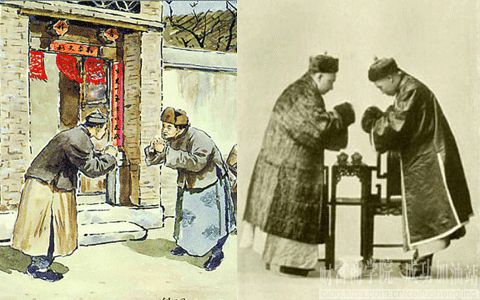Exploring the link between etiquettes and customs
Author : Zhang Qingli Source : Chinese Social Sciences Today 2014-12-23

One etiquette for ancient Chinese people is to salute with folded hands in front when making a bow at the same time, which is called zuō yī in Chinese.It is still a form of greetings nowadays, but with more meanings such as best wishes, congratulations and thanks.
Despite rapid modernization, traditional beliefs and cultural factors still influence many people’s lives. For contemporary scholars of humanities and social sciences, scientifically analyzing traditional Chinese culture holds the key to understanding the evolution of Chinese civilization.
Shandong University’s Advanced Institute for Confucian Studies held a symposium themed “Interaction between Etiquettes and Customs: Dialogue between History and Folkloristics” in Jinan on November 2, where scholars of the two disciplines discussed the relationship between etiquettes and customs.
According to the ancient Chinese text Zuo Zhuan (Chronicle of Zuo), etiquette refers to “the underlying rule for governing the country, the hierarchy for regulating social relations and behavioral norms for maintaining social order.”
Historically in China, the etiquette system mainly included social norms established for maintaining the overall function of the country and social order. They were usually in the form of institutional documents specified for all aspects of social life, while customs were regional norms passed on and developed in line with collective codes of conduct.
“Etiquettes and customs are intermediaries for one to understand a country and society,” said Chang Jianhua, a professor at Nankai University’s Key Research of Social History of China. Chang claimed that folk customs reflect ordinary social lives, while etiquettes are national customs influenced by the country, ideology and social elites. Ancient etiquettes to some extent are the outcome of practices promoted by influential scholars and officials, he said.
Local customs also exert their influence on the country, scholars and officials. Some of them are even included in the etiquette system after transformation. Etiquettes and customs interact with each other all the time.
In modern China, the essence of traditional culture is still fairly intact despite accelerating globalization. Folk customs are still being passed on, said Zhang Shishan, deputy director of the Folklore Research Institute at Shandong University, adding that some are even innovated amid the process of modernization.
During an investigation in rural Shandong’s Wazi county, Zhang observed that local villagers practice “old rituals” in organizing ceremonies, resolving disputes and integrating moral order. Villagers also use the concepts of xin (mind), xing (temper), tao and jiao (doctrine), gong (public), si (private), yi (justice), li (benefit), li (reasoning), li (courtesy) and other characters in various functions.
“In combination with local living practices, people have developed inflexible understandings and utilization of these characters, demonstrating how individual villagers or local communities influence and change each other,” said Zhang.
Gao Bingzhong, a professor of sociology at Peking University, said it is important to understand that etiquettes and customs of today differ from those of the past. From a cultural perspective, the idea for etiquettes and customs can be seen as a bipartite concept within the Chinese culture conducive to improving society.
Scholars at the symposium all agreed that issues concerning etiquettes and customs warrant research in terms of history and folkloristics. Chang said that etiquettes and customs are important in history studies, especially in the study of social history, and that research on etiquettes and customs require communication and corporation between history and folkloristics.
The Chinese version appeared in Chinese Social Sciences Today, No. 674, Dec 1, 2014.
The Chinese link: http://englishtest.cssn.cn/topstories/201411/t20141127_1418775.shtml
Translated by Du Mei
Revised by Tom Fearon
Ye Shengtao made Chinese fairy tales from a wilderness
Ye Shengtao (1894–1988) created the first collection of fairy tales in the history of Chinese children’s literature...
-
How northern ethnicities integrated into Chinese nation
2023-09-18
-
Mogao caves
2023-09-12
-
Mogao Grottoes as ‘a place of pilgrimage’
2023-09-12
-
Time-honored architectural traditions in China
2023-08-29
-
Disentangling the civilizational evolution of China
2023-08-28
-
AI ethics in science fiction
2023-08-23














 2011-2013 by www.cssn.cn. All Rights Reserved
2011-2013 by www.cssn.cn. All Rights Reserved